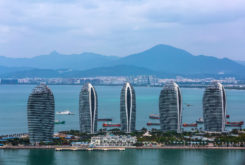Even before Portugal decided to take part in China´s Belt and Road strategy, with the signing of a joint statement at the end of Chinese president Xi Jinping´s visit to Portugal last week, the Portuguese government was already in full steam promoting what should be the key Portuguese infrastructure for the strategy – Sines port, in the south of the country.
At the same time, it is renegotiating the concession of the main terminal of this infrastructure to PSA – Port of Singapore Authority.
Eduardo Paz Ferreira (EPF), 65 , was chosen by the Portuguese Government to head the team that will renegotiate the concession of the Port of Sines (PortSines – Terminal Multipurpose de Sines), Portugal, with PSA – Sines Container Terminal, S.A., owned by PSA Singapore, which is expected to invest close to 100 million euros in the infrastructure.
He is professor at the University of Lisbon and specialized in tax law and public finances, married to the Angolan-born Portuguese minister of Justice, Francisca Van Dunem, and has a law firm (Paz Ferreira and Associates).
Paz Ferreira will head a team including José Luís Azevedo Cacho, president of the Ports of Sines and the Algarve Authority, and by Maria Ferreira Sequeira, president of APP – Association of Ports of Portugal. Two members appointed by the Finance ministry complete this commission.
The government´s objective is to have an investment of about EUR 100 million for the expansion of the container terminal. For PSA, the extension of the contract beyond 2019 is a condition.
Sines port concession was won by PSA in the late 1990’s in a process that, according to the Portuguese Audit Court, lacked transparency.
Mitsui & Co. Portugal and P&O Ports (UK) were two of the candidates that were excluded without a public tender.
Operations at the Sines container terminal, Terminal XXI, began in 2004 and the investment goals of the first phase of the project are considered fulfilled.
The Sines container terminal (Terminal XXI), has grown steadily, from 2004 (1,332,200 containers TEU) to more than 20 million (TEU) in recent years, which is equivalent to more than an half of the total number of containers moved in Portuguese continental ports and about 80% of the movements corresponding to transshipment cargo (containers unloaded from a ship and loaded on another).
Ports with terminals for transshipment operations are scarce globally. Oriented for maximum operating efficiency criteria which ultimately determine their success, they are designed as “hubs”, i.e., platforms of cargo handling between vessels of great ability who act on the intercontinental routes (e.g., Asia/Europe and transatlantic) and smaller vessels (feeders) dedicated to serve a particular region.
The success of a transshipment port depends on the extension of its coverage area. It is the case of Algeciras (Spain), which serves as a hub for the ports of North Africa, as well as to the rest of the Iberian Peninsula, competing with Sines and Tangiers.
It was precisely this skill of transshipment port which allowed Sines to achieve the leadership among the national ports and contributing for its only customer – Mediterranean Shipping Company / MSC – to become the leader of the Portuguese market to include local cargo (with final destination to Portugal) on its international routes, using Sines as a hub.
Despite the apparent success of Sines´ container terminal, the port did not attract the interest of other players for 14 years. Against a backdrop of prolonged labor conflicts, such as the one that occurred recently in the ports of Lisbon and Setubal with the dockers’ strikes, most of the shipping companies decided to transfer and concentrate operations in Leixões port (north), other than Sines.
In Sines, the progressive “capture” of the terminal by the single client model, limited its operating capacity becoming an inhibitory factor for other ship owners to consider its use.
Benefits originated by Sines container terminal are important for Portuguese foreign commerce. The use of the terminal as a turntable, in the strand of transshipment operations, constitutes the export of a service. However, the biggest advantage lies in the movement of goods, sold and bought by Portuguese companies, in ships with direct routes to/from Portugal, without costs of transshipment and dispensing the use of feeder ships, which reduces the charges of transport and travel times.
In the case of Sines, the situation has been different and exporters are complaining over the cost of the service, more expensive than from a competitor using Barcelona port.
Initially guided by the design of “continentalization”, due to the need for convergence and relationship with the European space, it ended up as a peripheral port and without scale. The current renegotiation process is thus a key moment not just for the future of Sines port but also of the Portuguese position as a strategic maritime turntable.
The Government must, according to economic players, go much further than only negotiating investment on infrastructure, but mostly redefine the overall concession model.
Chinese players, within the One Belt, One Road strategy (access to the global value chain), will have a word to say over the future of Sines, with the new terminal, “Vasco da Gama”.
Contacts started between the Portuguese government and, among others, Chinese maritime operator COSCO corporation.



